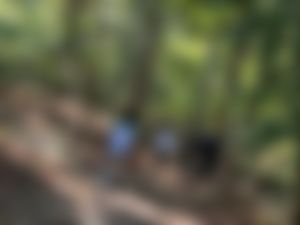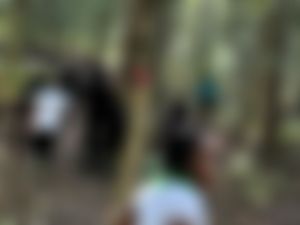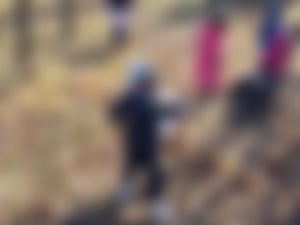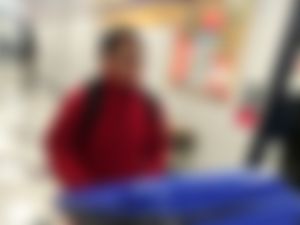Systemic Sustainability
Environmental Curriculum and Instruction
1.1 Curriculum and Instruction
Elementary & middle schools must provide one example of outdoor/environmental instruction per grade level.
High schools must provide one example of outdoor/environmental instruction in four subjects (which may include multiple different differents sciences).
Students participated in several experiments seeing how natural phenomenas effect landforms and bodies of water. They then discussed how human impact can change natural landforms.
Students went to the William Schmidt Outdoor Education Center (Camp Schmidt) for their annual 5th grade overnight trip. Students participate in Stream Ecology, Orienteering Challenge, Woodland Ecology (Nature Walk), Team Building, Problem Solving, and the Confidence Course.
Students were caught exploring the woods while looking for evidence of local wildlife.
Students were given several tasks to complete with a partner. Mr. Hall was giving thorough explanation on the tasks and how they can be safely carried out with their partner.
While being monitored, students continued to explore the woods for evidence of local wildlife. Students looked for tracks, animal waste and even animal sounds.
Students identified the recycle symbol on items in their class. They watched a video on recycle, reduce and reuse. They colored the recycle symbol and they have a recycle monitor in their class.
FOG- Fats, Oils & Grease- is a program from WSSC Water and is supported by the William Schmidt Outdoor Education Center. Students did experiments to see how dumping oils and grease down the drain can damage the environment by clogging piping and entering our local waterway.
SAVE Fat, Oil, and Grease Student Service Project 2024 (181.78 KB)
Slideshow of the lesson on SAVE, a service project of the FOG program.
Students learned about recycling and then completed a cut and glue sorting activity to identify what can be recycled, reduced and reused.
Students discussed the importance of recycling. They watched videos and shared the knowledge with parents at home. Students completed a diagram with illustrations to show what they learned.
Students discussed food waste, naming foods they often throw away and why. Students then kept track of the food they threw away at lunch and after lunch recorded their data. Students discussed reasons for throwing away their waste and ways to reduce food waste.
Students learned about what a watershed is and then identified their local watershed (Anacostia) as part of the Chesapeake Bay watershed using Google maps and the EPA Surf your Watershed site. Students then did a crumpled paper watershed activity to understand the flow of water and pollutants that can enter the watershed via human activities.
Students learned about what a carbon footprint is and what it means to practice sustainability. They used an online Google tool to determine their carbon footprint in four categories-food, water, energy and "stuff" and then reflected on ways they can reduce their footprint.
Students discussed the issues of recycling. They discussed the benefits of recycling and the pros\cons of recycling. They reiterated what things can be recycled and what items can not. They then wrote an opinion piece/ letter about recycling.
1.2 Green School Awareness
1.2.1 School Wide Awareness - Staff
Demonstrate that all school personnel are aware of your school's Green School status and application process.
During 1 staff meeting, I explained what the Green School Program is. I gave some suggestions on what we can do to keep our status as a Green School.
I reintroduced our Recycling Program. I suggested that we choose middle school students do the recycle collection for their service hours. Teachers suggested names of students.
Quick Snapshot of Our Green School_ (6.46 KB)
This is what i displayed to the teachers when I gave my introduction of Green School. I gave details on our application and answered any questions that were asked.
I explained some activities that classes could do to have us complete our Green School application. Mr. Gonzales said he would supervise middle school and their efforts, while I will supervise elementary.
1.2.2 School-Wide Celebration
Demonstrate how your school celebrates beig a Green School by hosting a school-wide environmentally-focused event open to all students.
During Earth Week, students will complete several activities daily to show their support of keeping our Earth healthy. At the end of the week, students have a celebration as a culminating activity of Earth Week.
Students will complete a waste pickup on school grounds. They will come together and celebrate their accomplishments by extra recess or a party provided by teachers.
Environmental Professional Development for Teachers
1.3.1 Environmental Professional Development for Teachers
Demonstrate that 10% of staff have completed an environmental PD. Instructional staff is defined as any staff that manages a gradebook.
- New Schools must have all PD completed within the past 2 academic years.
- Renewing schools must have all PD completed within the past 4 academic years.
A teacher who has participated in multiple workshops may only be counted once..
Teachers watched Safe School presentations on Energy Conservation and Indoor Air Quality. They attended 2 workshops that discussed our Green School application. We also had teachers that were a part of Camp Schmidt 5th grade training.
As a primary PE teacher. Mrs. Payne-Ristic believes that protecting our environment is extremely important. She goes out of her way to teach students the importance of recycling and reducing the energy usage in school. Mrs. Payne-Ristic watched the Safe Schools videos on Indoor Air Quality and Energy Conservation.
Certificate of Completion for Indoor Air Quality Awareness (Full Course) (2) (120.43 KB)
This is the Safe School Certificate of Completion for Air Quality.
Certificate of Completion for Energy Conservation_ All Staff (Full Course) (2) (120.39 KB)
This is the Safe School Certificate of Completion for Energy Conservation.
Ms. Yates is our TAG teacher. She reviewed Safe School Air Quality and Energy Conservation videos.
Ms. Mpanu-Mpanu is our Elementary Music Instructor. She has reviewed the Safe School Environment videos.
Certificate of Completion for Energy Conservation_ All Staff (Full Course) (1) (116.32 KB)
This is the Safe School Certificate of Completion for Energy Conservation.
As a kindergarten Science teacher. Mrs. Oliver believes that protecting our environment is extremely important. She goes out of her way to teach students the importance of recycling, She will be taking part of restoring our Butterfly Garden. Ms. Oliver watched the Safe Schools videos on Indoor Air Quality and Energy Conservation.
Certificate of Completion for Indoor Air Quality Awareness (Full Course) (88.94 KB)
These are the certificates that Mrs. Oliver was given after she completed her Safe School presentations. She is very much into making sure the world is a better place for her students.
Certificate of Completion for Energy Conservation_ All Staff (Full Course) (87.85 KB)
These are the certificates that Mrs. Oliver was given after she completed her Safe School presentations. She is very much into making sure the world is a better place for her students.
I am the Green School coordinator I am also the supervisor for our Middle School Recycling Team.
certificate-of-completion (73.02 KB)
This is the Safe School Certificate of Completion for the Green School Program.
Ms. Perkins is our 2nd Grade Reading Teacher. She has reviewed the Safe School Environmental videos.
1.4 Achieving Sustainable Schools
1.4.1 School-Wide Staff Sustainability
Demonstrate the sustainability practices your teachers, staff, and other personnel have implemented school-wide to make your school green. Any actions involving students belong under Objective 2.
We use Electronic Newsletters and energy Saving Mode on Electronics. Teachers are given a limited amount of copy paper, which encourages teachers to use 2 sided copying or white boards.
Students using Chromebooks to complete work assignments instead of paper. This is a great way for students to not use paper and save a tree in the process.
1.4.2 Systemic Partnership
Demonstrate one partnership with a central office or board within the school system that supports part of the Maryland Green Schools Program. Any partnerships outside of your school system belong under Objective 3.
Food and Nutrition Services use reusable crates to transport food. They also encourage students to recycle by having recycle bins located in the cafeteria. They use reusable crates to transport student snacks instead of bags.
Student Action
Schools must document eight total actions that address at least three of the listed sustainability practices.
These are student actions not adult actions. Adult sustainable actions can be documented in Objective 1.4.
2.1 Water Conservation/Pollution Prevention
2.1 Water Conservation/Pollution Prevention
Students collected trash from the front of our school alongside Green Leader Leslie Marcus from the William Schmidt Outdoor Education Center.
Students collecting trash near the runoff drain
Students cleaning our runoff area along the parking lot
Students using grabbers to collect trash
Students collecting trash
Students cleaning our runoff area.
Showing pride in helping the environment.
Student picking up trash
Students cleaning our runoff area.
Students in 2nd grade made signs reminding fellow students and staff to turn off the water when they are done.
2.2 Energy Conservation
2.2 Energy Conservation
Students made posters reminding fellow students and staff to turn off the lights when leaving a room.
2.3 Solid Waste Reduction
2.3 Solid Waste Reduction
William Hall recycles throughout the school building. Students assist in collecting the recycling when the bins are full and empty them into the larger recycle bin located outside.
2.4 Habitat Restoration
2.4 Habitat Restoration
At the beginning of the school year, students and parents banded together to plant new shrubs and trees. They also removed dead shrubs to prepare an area for our Butterfly Garden.
In a partnership with the William Schmidt Outdoor Education Center, students grow wild rice in their classroom. In April students will go on a field trip to learn about their watershed and plant their wild rice in the shallows of the Patuxent River. The rice is a native rice that provides habitat for aquatic life and is an important food source for migrating birds.
2.5 Opportunities for Nature Exploration
2.5 Opportunities for Nature Exploration
Students use the outdoor courtyard as an outdoor classroom. The area contains tables, benches and steps. Students were seeing what the effects of erosion and weathering have on the environment. We discussed how we can slow the process down to conserve landforms.
Using water and generated wind, students saw how the structures they built began to disappear because of weathering and erosion.
Using water and generated wind, students saw how the structures they built began to disappear because of weathering and erosion.
Students were testing see how much heat the sun produces compared to other heat sources.
Students were testing see how much heat the sun produces compared to other heat sources.
2.6 Responsible Transportation
2.6 Responsible Transportation
In our carpool circle, students either walk to and from school with either an adult or in groups with other children. We also have several van and cars that pick up multiple children to transport them safely to and from school.
2.7 Healthy Indoor Environments
2.7 Healthy Indoor Environments
Students use reusable water bottles through our filtered water fountain. This fountain also shows how many plastic bottles were saved.
Community Partnership
Demonstrate that your school is forming long-term partnerships to foster environmental stewardship and cultivate community wellness through real-world connections.
3.1 Community Partnerships
3.1.1 School Active in Community
Describe at least one environmentally-focused partnership in which your school is working to benefit your community.
Our school donates coats, hats and gloves to students and families in need every winter. Biweekly, we give groceries to families outside of the school. This includes fresh vegetables and meats. During the school year, we also donate school supplies, bookbags and uniforms to students when needed.
3.1.2 Community Active in the School
Describe at least one partnership in which a community partner is benefitting the school. These actions and projects occur on or near school grounds with support from the partner.
The William Schmidt Center has come to our school on several occasions to assists us with outdoor activities for our students. They also provide professional development to our teachers and support our efforts in certifying as a Green School. The Schmidt Center also provides programs to our students including, but not limited to, 7th grade Wild Rice, the 5th grade overnight trip and more.
3.2 Additional Achievements
3.2 Additional Achievements optional
Share any environmentally-related awards, special recognition, certifications, or other achievements that your school, staff or students have accomplished.
No records were added by the school.


























__20240304211724.JPG)































__20240226015041.jpeg)





